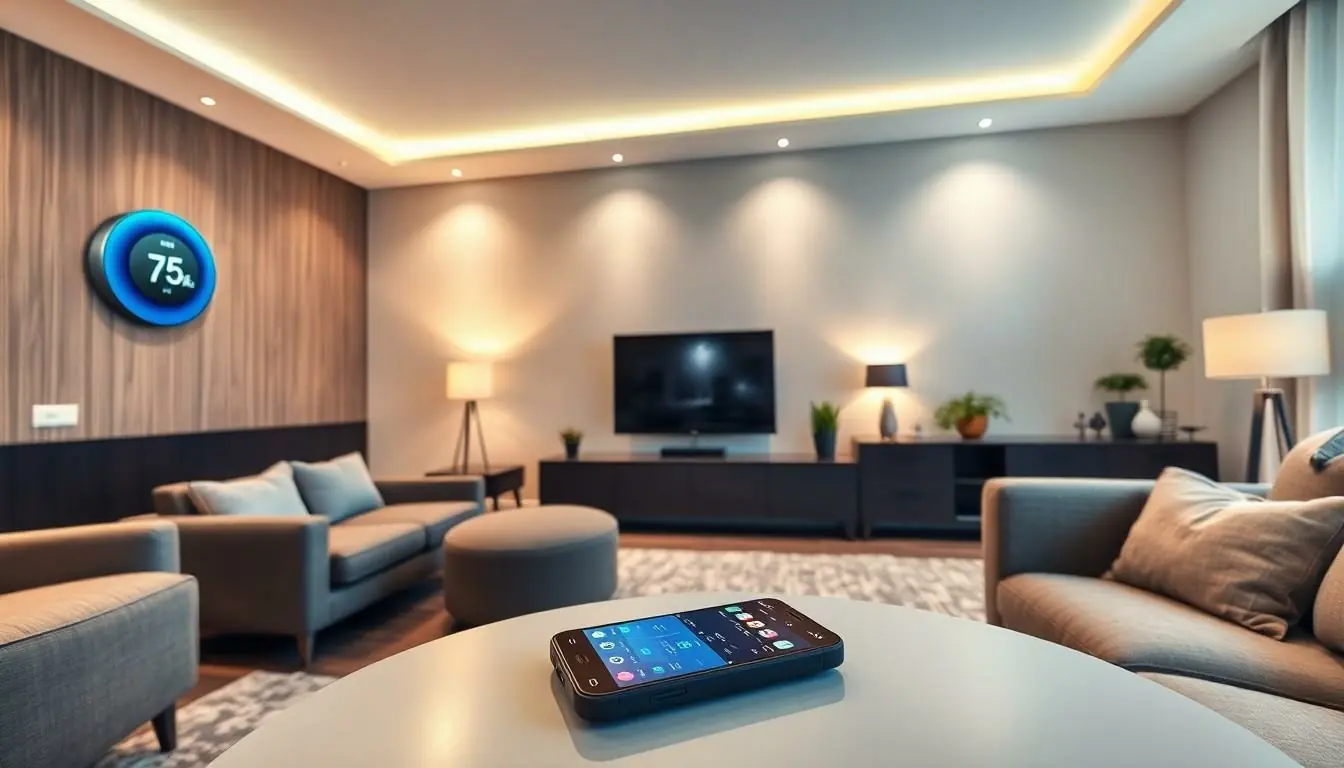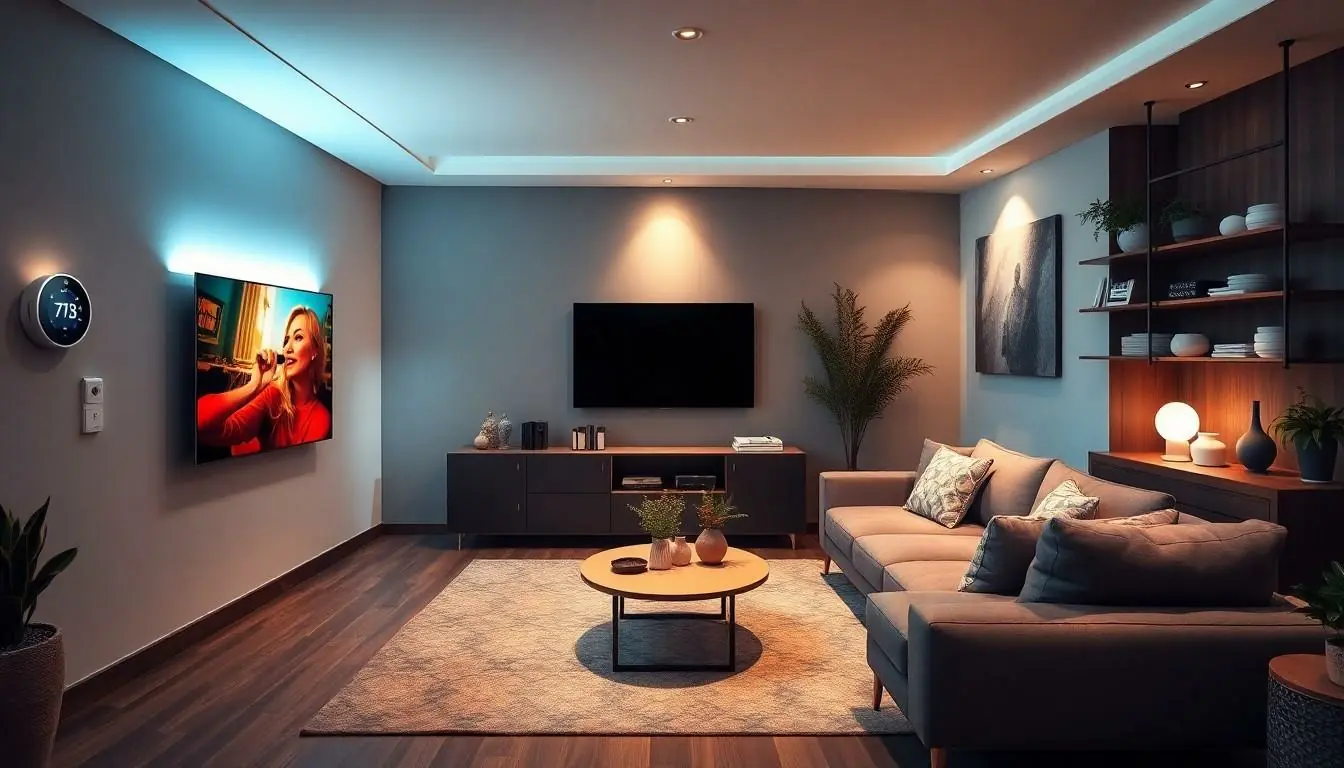Imagine walking into your home and having the lights adjust to your mood, the thermostat set just right, and your favorite playlist serenading you as you kick off your shoes. Sounds dreamy, right? Welcome to the world of smart homes, where technology meets convenience in a way that’ll make you feel like you’ve stepped into the future—without the flying cars (yet).
Table of Contents
ToggleUnderstanding Smart Homes
Smart homes integrate technology to enhance living experiences, providing convenience and improved quality of life. Home automation allows devices to communicate, creating an efficient and personalized environment.
Definition of Smart Homes
Smart homes refer to residences equipped with devices that communicate and automate tasks via networks. Automation involves controlling lighting, heating, and entertainment systems remotely for comfort. Sensors and smart devices contribute to safety, efficiency, and convenience, making everyday tasks easier. Homeowners can manage systems from smartphones or tablets, achieving a cohesive living space. Integration of artificial intelligence brings additional customization, learning user preferences over time.
Benefits of Smart Home Technology
Smart home technology offers numerous advantages that improve daily living. Enhanced security systems, including smart locks and surveillance cameras, protect homes from intruders. Energy efficiency is achieved through smart thermostats, which adjust temperatures based on occupancy. Increased convenience simplifies controls for lighting or appliances, allowing users to optimize their routines. Remote monitoring ensures peace of mind, letting homeowners check on their property from anywhere. This technology often results in cost savings through reduced energy consumption and maintenance.
Essential Components of a Smart Home

Smart homes consist of several key components that enhance utility and comfort. Each element plays a vital role in creating an integrated living space.
Smart Lighting Solutions
Smart lighting solutions provide flexibility and energy savings. Adjustable brightness levels cater to various activities, like reading or entertaining. Homeowners can control lights remotely using smartphones or voice commands. Systems like Philips Hue and LIFX offer customizable color options, enhancing ambiance. Scheduling features automate lighting based on daily routines, improving security when away. Motion sensors activate lights in response to presence, eliminating dark spots. Such advancements not only create mood but also reduce energy costs through efficient usage.
Smart Thermostats
Smart thermostats optimize heating and cooling, adjusting automatically based on occupancy patterns. Homeowners save energy and costs by programming temperatures to align with daily schedules. Devices such as Nest and Ecobee allow for remote adjustments via mobile apps. Historical data trends enable systems to learn user preferences over time. Compatibility with other smart devices further enhances control capabilities. Alerts notify users of temperature fluctuations, maintaining comfort and efficiency. These features contribute to a sustainable and cost-effective home environment.
Choosing the Right Smart Home Hub
Selecting an appropriate smart home hub is essential for streamlined device management. A smart home hub centralizes control, enabling diverse devices to communicate efficiently.
Popular Smart Home Hubs
Numerous smart home hubs cater to varying needs. Amazon Echo Plus integrates Alexa, allowing voice commands for multiple devices. Google Nest Hub supports Google Assistant, offering robust compatibility with various smart devices. Samsung SmartThings functions well with diverse ecosystems, supporting a wide range of products. Apple HomePod works best with Apple devices, providing a seamless user experience within the Apple ecosystem. Each hub presents unique strengths, allowing users to choose based on their preferences and existing devices.
Features to Consider
Several key features influence the selection of a smart home hub. Consider compatibility with various devices and platforms. Robust support for different protocols, like Zigbee and Z-Wave, enhances connectivity. User-friendly interfaces simplify navigation and device management. Security features, such as data encryption and secure access, protect user information. Additionally, availability of voice assistants can significantly improve user interaction and control. Prioritizing these features ensures an optimal smart home experience.
Setting Up Your Smart Home
Setting up a smart home involves a series of steps that streamline installation and device connections. Users can create a comfortable and efficient living space with the right planning.
Installation Process
Start by identifying the desired smart devices, such as smart lights, thermostats, and cameras. Choose locations for these devices based on functionality and convenience. Follow the manufacturer’s instructions for installation, ensuring power sources are accessible. Mounting devices usually requires simple tools. After physical installation, connect each device to the chosen smart home hub. Ensure all devices are up to date by checking for firmware updates during the setup process. This approach optimizes performance and enhances security.
Connecting Devices
Link devices to the smart home hub for seamless operation. Begin by opening the hub’s companion app and following prompts. Many devices utilize Wi-Fi or Bluetooth for connections, so ensure availability of a strong signal. Pair each device, responding to any configuration requests. Group compatible devices into scenes or rooms for efficient management. Users can customize how devices interact based on routines, enhancing automation. Verifying connections often improves user experience by confirming that everything operates as intended.
Security in Smart Homes
Smart home security enhances safety and peace of mind through advanced technology. Implementing various smart devices ensures homes stay secure while maintaining convenience.
Smart Security Cameras
Smart security cameras provide real-time surveillance and alert homeowners to unusual activities. Features like night vision and cloud storage enable 24/7 monitoring, allowing users to check live feeds from their smartphones. Many models support motion detection, sending notifications straight to devices when movement occurs. Some cameras integrate with smart hubs, enabling automation that can trigger lights or alarms based on detected motion. The ability to communicate with visitors using two-way audio further enhances security, enabling interaction from anywhere in the world.
Smart Alarms and Sensors
Smart alarms and sensors act as the first line of defense against intrusions. These devices include door/window sensors that alert homeowners when entries are breached. Many systems offer integration with existing security services for added protection. Smart smoke detectors provide alerts for smoke or carbon monoxide, ensuring immediate action can be taken in emergencies. In addition, motion sensors can be customized to recognize familiar faces, reducing false alarms from pets or family members. Their connectivity with other smart devices enables a comprehensive, automated security system that prioritizes user safety.
Embracing smart home technology transforms everyday living into a more efficient and enjoyable experience. By integrating automation into daily routines homeowners can enhance comfort and security while saving time and energy. The flexibility of smart devices allows for personalized environments that cater to individual preferences.
As technology continues to evolve the potential for smart homes will only grow. With careful planning and the right components anyone can create a connected space that meets their needs. Investing in smart home solutions not only simplifies life but also contributes to a sustainable future. Adopting these innovations today sets the stage for a more convenient tomorrow.





